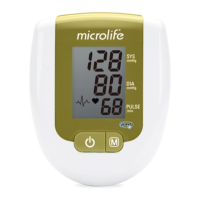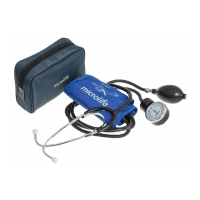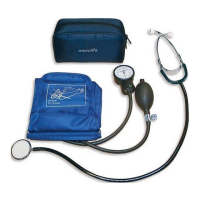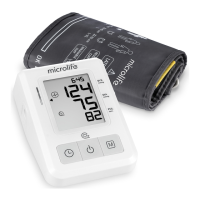Table for classifying blood-pressure values: World Health Organization (unit: mmHg)
Category Systolic Diastolic Recommendation
Hypotension < 100 < 60 Consult your doctor
Optimal < 120 < 80 Self-check
Normal < 130 < 85 Self-check
High-normal 130~139 85~89 Consult your doctor
Grade 1 hypertension (mild) 140~159 90~99 Consult your doctor
Grade 2 hypertension (moderate) 160~179 100~109 Consult your doctor
Grade 3 hypertension (severe) > 180 > 110 Consult your doctor immediately
Further information
• If your values are mostly “normal” under resting conditions but exceptionally high under
conditions of physical or psychological stress, it is possible that you are suffering from
so-called ”labile hypertension”. In any case, please discuss the values with your doctor.
• Correctly measured diastolic blood-pressure values above 120mmHg require immediate
medical treatment.
2.3. What can be done, if regular increased/low values are obtained?
• Please consult your doctor.
• Increased blood-pressure values (various forms of hypertension) over time are associat-
ed with considerable risks to health. Blood vessels in your body are endangered due to
constriction caused by deposits in the vessel walls (Arteriosclerosis). This can result in
a deficient supply of blood to important organs (heart, brain, muscles). Additionally, the
heart will become structurally damaged.
• There are many different causes of high blood pressure. We differentiate between the
common primary (essential) hypertension, and secondary hypertension. Secondary
hypertension can cause organ malfunctions. Please consult your doctor for information
about the possible origins of your own increased blood pressure values.
• There are lifestyle changes you can make to prevent and reduce high blood pressure.
These measures must be part of a healthy lifestyle and include:
Eating habits
• Maintain a normal weight as prescribed by your doctor.
• Avoid excessive consumption of common salt. Please note many
"packaged foods” contain high levels of salt.
• Avoid fatty foods. (Packaged foods are frequently high in fats)
Previous illnesses
Consistently follow any medical instructions for treating
previous illness such as:
• Diabetes (Diabetes mellitus or sugar diabetes)
• Fat metabolism disorder
• Gout
Habits
• Eliminate smoking
• Drink only moderate amounts of alcohol
• Restrict your caffeine consumption (Coffee, tea, chocolate, etc.)
Physical conditioning
• After a preliminary medical examination, exercise regularly.
• Choose sports which require endurance and avoid those which
require strength.
• Avoid reaching the limit of your performance.
• With previous illnesses and/or an age of over 40 years, please
consult your doctor before beginning your exercise routine. Your
physician will help you develop an exercise routine that is appro-
priate for you.
BP 3BM1-3 Automatic Blood Pressure Monitor Instruction Manual www.microlife.com www.microlife.com BP 3BM1-3 Automatic Blood Pressure Monitor Instruction Manual
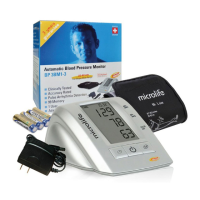
